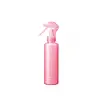What's inside
What's inside
 Key Ingredients
Key Ingredients

 Benefits
Benefits

 Concerns
Concerns

 Ingredients Side-by-side
Ingredients Side-by-side

Water
Skin ConditioningAlcohol
AntimicrobialAmodimethicone
Glycerin
HumectantPhenoxyethanol
PreservativeCetrimonium Chloride
AntimicrobialDimethicone
EmollientSodium Citrate
BufferingDicocodimonium Chloride
EmulsifyingCitric Acid
BufferingSteartrimonium Chloride
PreservativePEG-200 Hydrogenated Castor Oil
EmulsifyingHydrolyzed Hyaluronic Acid
HumectantCreatine
Skin ConditioningCetearamidoethyl Diethonium Hydrolyzed Rice Protein
Sodium Dilauramidoglutamide Lysine
HumectantPropanediol
SolventDistearyldimonium Chloride
Behentrimonium Chloride
PreservativeGamma-Docosalactone
Skin ConditioningPhytosterols
Skin ConditioningCeteth-20
CleansingIsopropyl Alcohol
SolventWater, Alcohol, Amodimethicone, Glycerin, Phenoxyethanol, Cetrimonium Chloride, Dimethicone, Sodium Citrate, Dicocodimonium Chloride, Citric Acid, Steartrimonium Chloride, PEG-200 Hydrogenated Castor Oil, Hydrolyzed Hyaluronic Acid, Creatine, Cetearamidoethyl Diethonium Hydrolyzed Rice Protein, Sodium Dilauramidoglutamide Lysine, Propanediol, Distearyldimonium Chloride, Behentrimonium Chloride, Gamma-Docosalactone, Phytosterols, Ceteth-20, Isopropyl Alcohol
Water
Skin ConditioningDimethicone
EmollientCaprylic/Capric Triglyceride
MaskingDiphenylsiloxy Phenyl Trimethicone
Skin ConditioningCetyl Alcohol
EmollientIsopentyldiol
HumectantSoluble Collagen
HumectantKeratin
Skin ConditioningPEG-3 Tallow Propylenedimonium Dimethosulfate
Levulinic Acid
PerfumingSqualane
EmollientEuterpe Oleracea Fruit Oil
Skin ConditioningVitis Vinifera Seed Oil
EmollientBifidobacterium
Skin ProtectingYeast Extract
Skin ConditioningEnterococcus Faecalis
HumectantAzelaic Acid
BufferingGamma-Docosalactone
Skin ConditioningLactose
HumectantMilk Protein
Skin ConditioningBehentrimonium Methosulfate
Hydroxyethylcellulose
Emulsion StabilisingDicocodimonium Chloride
EmulsifyingHydroxypropyl Methylcellulose Stearoxy Ether
Steartrimonium Chloride
PreservativeDimethiconol
EmollientAmodimethicone
Glyceryl Stearate
EmollientCetrimonium Chloride
AntimicrobialHydrogenated Starch Hydrolysate
HumectantDiethyl Sebacate
EmollientTocopherol
AntioxidantCitric Acid
BufferingDisodium EDTA
Glycerin
HumectantButylene Glycol
HumectantPhenoxyethanol
PreservativeCI 15985
Cosmetic ColorantCaramel
Cosmetic ColorantParfum
MaskingWater, Dimethicone, Caprylic/Capric Triglyceride, Diphenylsiloxy Phenyl Trimethicone, Cetyl Alcohol, Isopentyldiol, Soluble Collagen, Keratin, PEG-3 Tallow Propylenedimonium Dimethosulfate, Levulinic Acid, Squalane, Euterpe Oleracea Fruit Oil, Vitis Vinifera Seed Oil, Bifidobacterium, Yeast Extract, Enterococcus Faecalis, Azelaic Acid, Gamma-Docosalactone, Lactose, Milk Protein, Behentrimonium Methosulfate, Hydroxyethylcellulose, Dicocodimonium Chloride, Hydroxypropyl Methylcellulose Stearoxy Ether, Steartrimonium Chloride, Dimethiconol, Amodimethicone, Glyceryl Stearate, Cetrimonium Chloride, Hydrogenated Starch Hydrolysate, Diethyl Sebacate, Tocopherol, Citric Acid, Disodium EDTA, Glycerin, Butylene Glycol, Phenoxyethanol, CI 15985, Caramel, Parfum
Ingredients Explained
These ingredients are found in both products.
Ingredients higher up in an ingredient list are typically present in a larger amount.
This water-soluble silicone is used for its hydrating and softening properties. It is used to add a silky feel to skincare products and has great benefits for haircare.
In haircare, this ingredient:
- Adds shine
- Protects color
- Offers thermal protection
- Boosts hair strength
- Does not build up as easily
This ingredient is a preservative, antimicrobial, and emulsifier. It is often used in cosmetics for its ability to cleanse, condition, and reduce static.
Cetrimonium chloride is a quaternary ammonium salt, meaning it has a water-soluble structure.
Citric Acid is an alpha hydroxy acid (AHA) naturally found in citrus fruits like oranges, lemons, and limes.
Like other AHAs, citric acid can exfoliate skin by breaking down the bonds that hold dead skin cells together. This helps reveal smoother and brighter skin underneath.
However, this exfoliating effect only happens at high concentrations (20%) which can be hard to find in cosmetic products.
Due to this, citric acid is usually included in small amounts as a pH adjuster. This helps keep products slightly more acidic and compatible with skin's natural pH.
In skincare formulas, citric acid can:
While it can provide some skin benefits, research shows lactic acid and glycolic acid are generally more effective and less irritating exfoliants.
Most citric acid used in skincare today is made by fermenting sugars (usually from molasses). This synthetic version is identical to the natural citrus form but easier to stabilize and use in formulations.
Read more about some other popular AHA's here:
Learn more about Citric AcidWe don't have a description for Dicocodimonium Chloride yet.
Dimethicone is a type of synthetic silicone created from natural materials such as quartz.
What it does:
Dimethicone comes in different viscosities:
Depending on the viscosity, dimethicone has different properties.
Ingredients lists don't always show which type is used, so we recommend reaching out to the brand if you have questions about the viscosity.
This ingredient is unlikely to cause irritation because it does not get absorbed into skin. However, people with silicone allergies should be careful about using this ingredient.
Note: Dimethicone may contribute to pilling. This is because it is not oil or water soluble, so pilling may occur when layered with products. When mixed with heavy oils in a formula, the outcome is also quite greasy.
Learn more about DimethiconeWe don't have a description for Gamma-Docosalactone yet.
Glycerin is already naturally found in your skin. It helps moisturize and protect your skin.
A study from 2016 found glycerin to be more effective as a humectant than AHAs and hyaluronic acid.
As a humectant, it helps the skin stay hydrated by pulling moisture to your skin. The low molecular weight of glycerin allows it to pull moisture into the deeper layers of your skin.
Hydrated skin improves your skin barrier; Your skin barrier helps protect against irritants and bacteria.
Glycerin has also been found to have antimicrobial and antiviral properties. Due to these properties, glycerin is often used in wound and burn treatments.
In cosmetics, glycerin is usually derived from plants such as soybean or palm. However, it can also be sourced from animals, such as tallow or animal fat.
This ingredient is organic, colorless, odorless, and non-toxic.
Glycerin is the name for this ingredient in American English. British English uses Glycerol/Glycerine.
Learn more about GlycerinPhenoxyethanol is a preservative that has germicide, antimicrobial, and aromatic properties. Studies show that phenoxyethanol can prevent microbial growth. By itself, it has a scent that is similar to that of a rose.
It's often used in formulations along with Caprylyl Glycol to preserve the shelf life of products.
Steartrimonium Chloride is a preservative.
Water. It's the most common cosmetic ingredient of all. You'll usually see it at the top of ingredient lists, meaning that it makes up the largest part of the product.
So why is it so popular? Water most often acts as a solvent - this means that it helps dissolve other ingredients into the formulation.
You'll also recognize water as that liquid we all need to stay alive. If you see this, drink a glass of water. Stay hydrated!
Learn more about Water